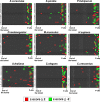A comparative genomics study on the effect of individual amino acids on ribosome stalling
- PMID: 26449596
- PMCID: PMC4602185
- DOI: 10.1186/1471-2164-16-S10-S5
A comparative genomics study on the effect of individual amino acids on ribosome stalling
Abstract
Background: During protein synthesis, the nascent peptide chain emerges from the ribosome through the ribosomal exit tunnel. Biochemical interactions between the nascent peptide and the tunnel may stall the ribosome movement and thus affect the expression level of the protein being synthesized. Earlier studies focused on one model organism (S. cerevisiae), have suggested that certain amino acid sequences may be responsible for ribosome stalling; however, the stalling effect at the individual amino acid level across many organisms has not yet been quantified.
Results: By analyzing multiple ribosome profiling datasets from different organisms (including prokaryotes and eukaryotes), we report for the first time the organism-specific amino acids that significantly lead to ribosome stalling. We show that the identity of the stalling amino acids vary across the tree of life. In agreement with previous studies, we observed a remarkable stalling signal of proline and arginine in S. cerevisiae. In addition, our analysis supports the conjecture that the stalling effect of positively charged amino acids is not universal and that in certain conditions, negative charge may also induce ribosome stalling. Finally, we show that the beginning part of the tunnel tends to undergo more interactions with the translated amino acids than other positions along the tunnel.
Conclusions: The reported results support the conjecture that the ribosomal exit tunnel interacts with various amino acids and that the nature of these interactions varies among different organisms. Our findings should contribute towards better understanding of transcript and proteomic evolution and translation elongation regulation.
Figures





Similar articles
-
Computational analysis of nascent peptides that induce ribosome stalling and their proteomic distribution in Saccharomyces cerevisiae.RNA. 2017 Jul;23(7):983-994. doi: 10.1261/rna.059188.116. Epub 2017 Mar 31. RNA. 2017. PMID: 28363900 Free PMC article.
-
Reverse genetics-based biochemical studies of the ribosomal exit tunnel constriction region in eukaryotic ribosome stalling: spatial allocation of the regulatory nascent peptide at the constriction.Nucleic Acids Res. 2020 Feb 28;48(4):1985-1999. doi: 10.1093/nar/gkz1190. Nucleic Acids Res. 2020. PMID: 31875230 Free PMC article.
-
Genetic identification of nascent peptides that induce ribosome stalling.J Biol Chem. 2009 Dec 11;284(50):34809-18. doi: 10.1074/jbc.M109.039040. Epub 2009 Oct 19. J Biol Chem. 2009. PMID: 19840930 Free PMC article.
-
Translation regulation via nascent polypeptide-mediated ribosome stalling.Curr Opin Struct Biol. 2016 Apr;37:123-33. doi: 10.1016/j.sbi.2016.01.008. Epub 2016 Feb 7. Curr Opin Struct Biol. 2016. PMID: 26859868 Review.
-
Ribosome regulation by the nascent peptide.Microbiol Rev. 1996 Jun;60(2):366-85. doi: 10.1128/mr.60.2.366-385.1996. Microbiol Rev. 1996. PMID: 8801438 Free PMC article. Review.
Cited by
-
Deciphering the rules of mRNA structure differentiation in Saccharomyces cerevisiae in vivo and in vitro with deep neural networks.RNA Biol. 2019 Aug;16(8):1044-1054. doi: 10.1080/15476286.2019.1612692. Epub 2019 May 23. RNA Biol. 2019. PMID: 31119975 Free PMC article.
-
The Multifaceted Roles of Proline in Cell Behavior.Front Cell Dev Biol. 2021 Aug 12;9:728576. doi: 10.3389/fcell.2021.728576. eCollection 2021. Front Cell Dev Biol. 2021. PMID: 34458276 Free PMC article. Review.
-
The stop-and-go traffic regulating protein biogenesis: How translation kinetics controls proteostasis.J Biol Chem. 2019 Feb 8;294(6):2076-2084. doi: 10.1074/jbc.REV118.002814. Epub 2018 Nov 30. J Biol Chem. 2019. PMID: 30504455 Free PMC article. Review.
-
The impact of ribosomal interference, codon usage, and exit tunnel interactions on translation elongation rate variation.PLoS Genet. 2018 Jan 16;14(1):e1007166. doi: 10.1371/journal.pgen.1007166. eCollection 2018 Jan. PLoS Genet. 2018. PMID: 29337993 Free PMC article.
-
The translation attenuating arginine-rich sequence in the extended signal peptide of the protein-tyrosine phosphatase PTPRJ/DEP1 is conserved in mammals.PLoS One. 2020 Dec 9;15(12):e0240498. doi: 10.1371/journal.pone.0240498. eCollection 2020. PLoS One. 2020. PMID: 33296397 Free PMC article.
References
-
- Kanaya S, Yamada Y, Kinouchi M, Kudo Y, Ikemura T. Codon usage and tRNA genes in eukaryotes: correlation of codon usage diversity with translation efficiency and with CG-dinucleotide usage as assessed by multivariate analysis. Journal of molecular evolution. 2001;53(4-5):290–298. - PubMed
-
- Gustafsson C, Govindarajan S, Minshull J. Codon bias and heterologous protein expression. Trends in biotechnology. 2004;22(7):346–353. - PubMed
-
- Sørensen MA, Kurland C, Pedersen S. Codon usage determines translation rate in Escherichia coli. Journal of molecular biology. 1989;207(2):365–377. - PubMed
-
- Varenne S, Buc J, Lloubes R, Lazdunski C. Translation is a non-uniform process: effect of tRNA availability on the rate of elongation of nascent polypeptide chains. Journal of molecular biology. 1984;180(3):549–576. - PubMed
Publication types
MeSH terms
Substances
LinkOut - more resources
Full Text Sources
Molecular Biology Databases

